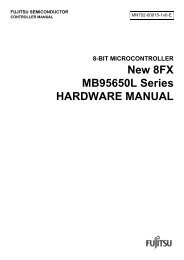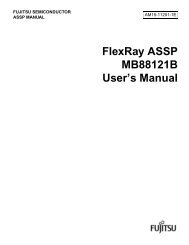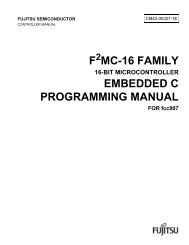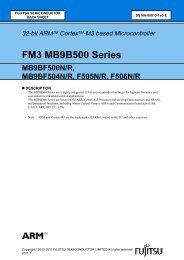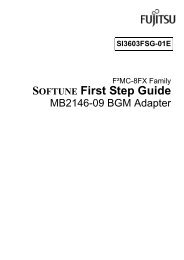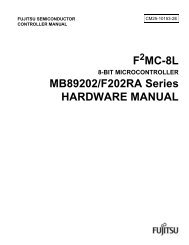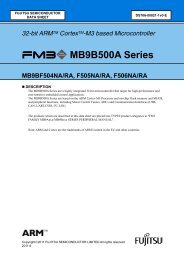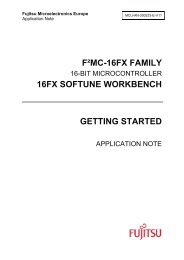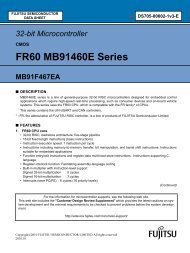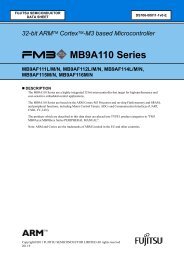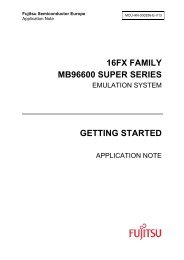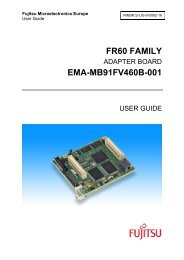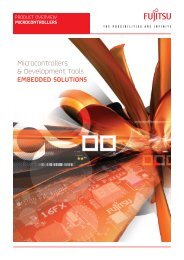J-Link / J-Trace User Guide (UM08001) - Microcontrollers
J-Link / J-Trace User Guide (UM08001) - Microcontrollers
J-Link / J-Trace User Guide (UM08001) - Microcontrollers
You also want an ePaper? Increase the reach of your titles
YUMPU automatically turns print PDFs into web optimized ePapers that Google loves.
172 CHAPTER 8 Target interfaces and adapters<br />
8.1 20-pin JTAG/SWD connector<br />
8.1.1 Pinout for JTAG<br />
J-<strong>Link</strong> and J-<strong>Trace</strong> have a JTAG connector compatible<br />
to ARM’s Multi-ICE. The JTAG connector is a 20<br />
way Insulation Displacement Connector (IDC) keyed<br />
box header (2.54mm male) that mates with IDC<br />
sockets mounted on a ribbon cable.<br />
The following table lists the J-<strong>Link</strong> / J-<strong>Trace</strong> JTAG<br />
pinout.<br />
PIN SIGNAL TYPE Description<br />
1 VTref Input<br />
2<br />
Not connected<br />
3 nTRST Output<br />
5 TDI Output<br />
7 TMS Output<br />
9 TCK Output<br />
11 RTCK Input<br />
13 TDO Input<br />
15 RESET I/O<br />
17 DBGRQ NC<br />
19<br />
5V-Supply<br />
This is the target reference voltage. It is used to check if<br />
the target has power, to create the logic-level reference for<br />
the input comparators and to control the output logic levels<br />
to the target. It is normally fed from Vdd of the target board<br />
and must not have a series resistor.<br />
NC This pin is not connected in J-<strong>Link</strong>.<br />
Output<br />
Table 8.1: J-<strong>Link</strong> / J-<strong>Trace</strong> pinout<br />
VTref 1 2 NC<br />
nTRST 3 4 GND<br />
TDI<br />
5 6 GND<br />
TMS 7 8 GND<br />
TCK 9 10 GND<br />
RTCK 11 12 GND<br />
TDO 13 14 GND<br />
RESET 15 16 GND<br />
DBGRQ 17 18 GND<br />
5V-Supply 19 20 GND<br />
JTAG Reset. Output from J-<strong>Link</strong> to the Reset signal of the<br />
target JTAG port. Typically connected to nTRST of the target<br />
CPU. This pin is normally pulled HIGH on the target to avoid<br />
unintentional resets when there is no connection.<br />
JTAG data input of target CPU.- It is recommended that this<br />
pin is pulled to a defined state on the target board. Typically<br />
connected to TDI of the target CPU.<br />
JTAG mode set input of target CPU. This pin should be<br />
pulled up on the target. Typically connected to TMS of the<br />
target CPU.<br />
JTAG clock signal to target CPU. It is recommended that this<br />
pin is pulled to a defined state of the target board. Typically<br />
connected to TCK of the target CPU.<br />
Return test clock signal from the target. Some targets must<br />
synchronize the JTAG inputs to internal clocks. To assist in<br />
meeting this requirement, you can use a returned, and<br />
retimed, TCK to dynamically control the TCK rate. J-<strong>Link</strong><br />
supports adaptive clocking, which waits for TCK changes to<br />
be echoed correctly before making further changes. Connect<br />
to RTCK if available, otherwise to GND.<br />
JTAG data output from target CPU. Typically connected to<br />
TDO of the target CPU.<br />
Target CPU reset signal. Typically connected to the RESET<br />
pin of the target CPU, which is typically called "nRST",<br />
"nRESET" or "RESET".<br />
This pin is not connected in J-<strong>Link</strong>. It is reserved for compatibility<br />
with other equipment to be used as a debug<br />
request signal to the target system. Typically connected to<br />
DBGRQ if available, otherwise left open.<br />
This pin can be used to supply power to the target hardware.<br />
Older J-<strong>Link</strong>s may not be able to supply power on this<br />
pin. For more information about how to enable/disable the<br />
power supply, please refer to Target power supply on<br />
page 174.<br />
J-<strong>Link</strong> / J-<strong>Trace</strong> (<strong>UM08001</strong>) © 2004-2010 SEGGER Microcontroller GmbH & Co. KG



